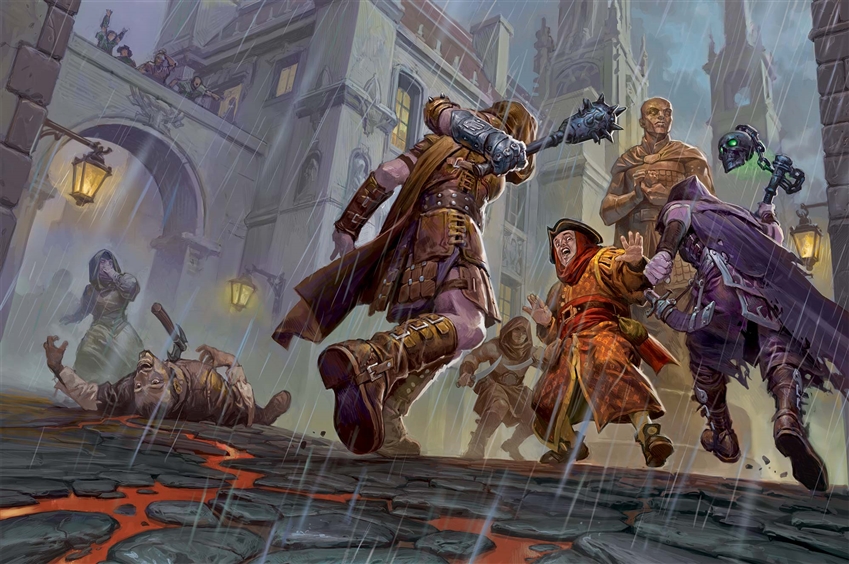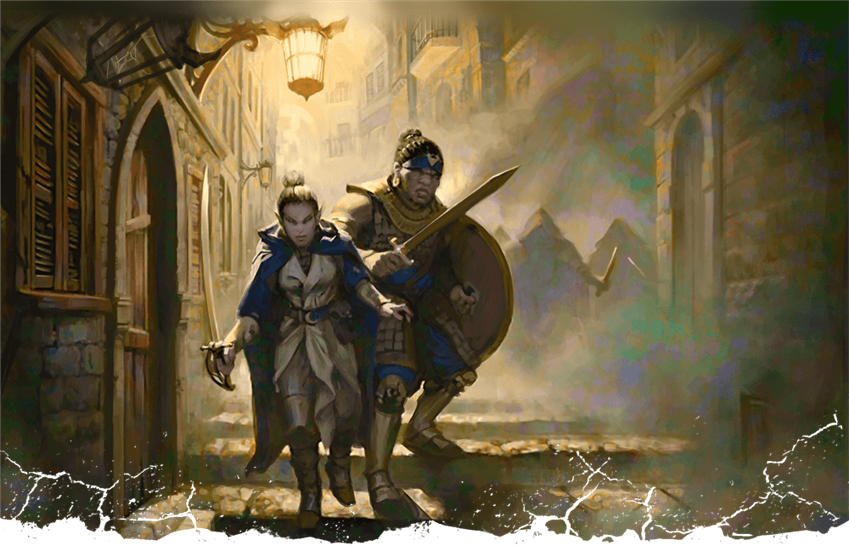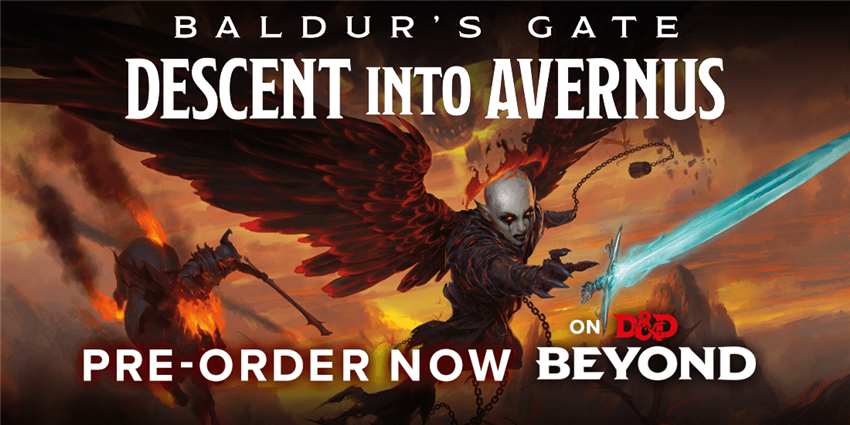The Road to Baldur’s Gate has reached its end. Now that you’ve completed Encounter of the Week: River of the Damned, how do you transition your road trip campaign into Baldur’s Gate: Descent into Avernus? These characters have dealt with devils, battled demons, and learned of a shadowy conspiracy within the realm of Elturgard. All of these themes are present in Avernus, but you’ll need to do a bit of work to bridge the gap without making the Baldur’s Gate content in Descent into Avernus feel like an afterthought.
To make a long story short, here are the two primary ways I would recommend altering chapter 1 of Baldur’s Gate: Descent into Avernus to connect it with the Road to Baldur’s Gate encounter series.

Option 1: Scale Up Levels
This option is the easiest to handle, narratively, but the hardest mechanically. In this route, the characters arrive at the Basilisk Gate of Baldur’s Gate in a time of relative peace. The adventurers successfully completed the long journey from Waterdeep to Baldur’s Gate, and now they have a few days to kick back and relax before picking up whatever business they wanted to do in Baldur’s Gate. Look through the Baldur’s Gate Gazetteer in the appendices of Descent into Avernus for information about the city, and some activities that the characters could participate in after arriving in the city.
From here, ask your players outright what their characters’ goals are, and maybe even tell them that the next leg of the adventure will involve them performing mercenary work for the Flaming Fist mercenary company, and working out a way that their goals as characters and your goals as a DM can align. Now you get to do some work behind the scenes. Read through chapter 1 of Descent into Avernus and take note of the most significant encounters. If you’re a D&D Beyond subscriber, you can use the Encounter Builder to easily scale up the 1st-level encounters to challenge your 4th-level party by using harder monsters, or just by increasing the number of monsters they face.
Also, consider reducing the XP the encounters in chapter 1 award by 75%. This will slow down XP gain enough to help the book catch up with the party around the time they descend into Avernus, so you won’t have to do any more reworking of combat encounters in the future. Once that’s taken care of, start the next session with them each receiving a letter from Captain Darmin Zodge of the Flaming Fist, reuniting the party and summoning them to the Basilisk Gate for a job. And so the campaign begins anew…

Option 2: Skip Baldur’s Gate
It feels like a shame to skip over perfectly good content, especially when the portion of Descent into Avernus that takes place in Baldur’s Gate and the Baldur’s Gate Gazetteer number around 100 total pages in length. Nevertheless, once the characters arrive in Baldur’s Gate, you can simply skip two weeks into the future and assume that some other group of adventures took care of all the sinister dealings in Baldur’s Gate. In the break between sessions, ask the players to think of what their characters did in Baldur’s Gate over the past two tendays. Then, start next session by asking them to describe their solo misadventures. Once the players are done, skip to the “Final Encounters in Baldur’s Gate” section in chapter 1 of Baldur’s Gate: Descent into Avernus. From there, describe how Commander Liara Portyr of the Flaming Fist has returned to Baldur’s Gate and personally requested the adventurers, having heard of their reputation. She recaps what has happened in the depths of Baldur’s Gate (the parts of chapter 1 that they weren’t present for), and notes that the adventurers who were involved in these matters were unceremoniously killed just two days ago. Now, she wants the characters to pick up the loose ends and help Baldur’s Gate and Elturel alike.
Option 3: Doing it Yourself
There is another option, of course. Take matters into your own hands and create a brand-new, bespoke method of getting your characters to Avernus.
There are several hurdles to face here, but all can be easily overcome if you work cleverly. Keep this article handy once you get your copy of Baldur’s Gate: Descent into Avernus, either as a hardback book, or as a compendium entry on D&D Beyond. If you’ve never deliberately adapted the beginning of a full adventure to suit an existing party before, that’s okay. There are five simple steps to follow:

- Assess your characters
- Assess the material
- Find breaking points
- Find commonalities
- Adapt and create hooks
Assess your Characters
The first thing to do when adapting part of a major D&D adventure is to look at your party. What have they accomplished so far? What are their goals? How do their characters work together, and what sort of things are they likely to do together going forward?
Many published adventures start by presenting the characters with a single obvious goal, and expect them to work together towards that goal, even if it doesn’t fit their character goals. Many D&D players go along with this, since it helps to have a starting objective so you don’t spend the first two hours of your first session arguing over what to do. Within this first quest, all of the players have the opportunity to get a feeling for how they want to play their characters, and the DM also has a chance to get used to these characters. Once everyone is comfortable with their own character and with their fellow party members, then they can make more decisive character-driven decisions within the environment the DM has provided them with.
Assess the Material
I can’t assess the opening chapter of Baldur’s Gate: Descent into Avernus for you without divulging spoilers, but I encourage you to read the About This Adventure section and the book’s first chapter once over—just skimming—as soon as you get it. Look for things such as:
- The campaign’s outline; where can the story of the Road to Baldur’s Gate connect?
- The very beginning of the campaign; can you make the threads connect?
- The level of the beginning of the campaign; do you need to adapt any of the encounters, or do the levels match up closely enough?
- Early plot hooks within the book; if the lowest-level plot hooks don’t work well, can you create a new plot hook that ties into something a few levels later?
Find Breaking Points
Now that you’ve examined both your characters and your adventure, it’s time to identify places where the two don’t get along.
With these ideas in mind, it’s fairly easy to see why it’s a bit challenging to start Baldur’s Gate: Descent into Avernus with 4th-level characters that have adventured together for a full month already. The adventure begins with the characters arriving at the entrance of Baldur’s Gate—a good start—but then reveals that something has happened to Elturel, and refugees are already pouring in. Somehow, about a tenday or so needs to pass between the characters’ arrival and the adventure’s beginning, since they were just in Elturel a few days ago.
Following that, the adventure presents the characters with a straightforward quest that slowly kicks off the main plot and gives the players a chance to get familiar with their party. Standard, but not useful for folks who’ve already been playing together for a while.
Find Commonalities
Now that we’ve identified points of friction between your characters and your adventure, let’s find points of silky smoothness. Where do they line up almost perfect?
Fortunately, the “you’ve been hired as mercenaries” beginning of Descent into Avernus also provides an easy in—as long as your players don’t mind being hired as mercenaries. Once you’ve asked them what they want to do, you may want to explicitly tell your players that you’ll find a way to work their characters goals into the adventure, and you’d like them to buy into your premise of performing mercenary work.
Look through chapter 1 and see if there are any other bits of the plot that tie into your characters’ motivations. Cults? Political corruption? The Dead Three? Devils? Once you’ve identified those points of commonality, you can start to make them more prominent, so your characters have a direct reason to actively participate in the story.
Adapt and Create Hooks
Now that you’ve read the material and identified its most (and least) useful sections, it’s time to synthesize all of that into an actual game. The most important part of this step is revealing tantalizing secrets to your players. As a Dungeon Master, you want to walk the tightrope of teasing your players with story mysteries while still allowing them to discover enough information to make informed character choices. Without sufficient information, they can only follow where the plot takes them—and that leads to the feeling of railroading, of being led by the nose through a plot where nothing directly concerns them and nothing makes sense.
In a story as twisty and mysteries as Baldur’s Gate: Descent into Avernus, getting a feel for how much information to give away is crucial. It’s an art, not a science; a sweet spot that you can only find by judging your own feelings and your own players’ reactions. No matter what, it’s not going to be absolutely perfect, so just do your best.

Preorder your copy of Baldur’s Gate: Descent into Avernus, now in the D&D Beyond Marketplace!
 James Haeck is the lead writer for D&D Beyond, the co-author of Waterdeep: Dragon Heist and the Critical Role Tal'Dorei Campaign Setting, a member of the Guild Adepts, and a freelance writer for Wizards of the Coast, the D&D Adventurers League, and other RPG companies. He lives in Seattle, Washington with his partner Hannah and their animal companions Mei and Marzipan. You can find him wasting time on Twitter at @jamesjhaeck.
James Haeck is the lead writer for D&D Beyond, the co-author of Waterdeep: Dragon Heist and the Critical Role Tal'Dorei Campaign Setting, a member of the Guild Adepts, and a freelance writer for Wizards of the Coast, the D&D Adventurers League, and other RPG companies. He lives in Seattle, Washington with his partner Hannah and their animal companions Mei and Marzipan. You can find him wasting time on Twitter at @jamesjhaeck.








-
View User Profile
-
Send Message
Posted Sep 16, 2019I will need to do this for my party or have them make new characters.
-
View User Profile
-
Send Message
Posted Sep 16, 2019This series has been a delight in seeing an example of a Location based adventure using an episodic format as described in the DMG. You've provided inspiration for countless DMs, myself included. Thank you.
-
View User Profile
-
Send Message
Posted Sep 16, 2019This series was the contributing factor to my preorder of BG:DiA, barely edging out the upcoming AL rule changes. Good work, and I hope that Encounter of the Week continues with some fresh ideas!
-
View User Profile
-
Send Message
Posted Sep 17, 2019I recently began a campaign with my mother and little brother that I've decided to gear largely around downtime and transitions between different published adventures. This is a primarily GoS campaign, but I intend to segue into tFoF (from TftYP) scaled to 4th-5th level. I'm thinking that I could use elements of this adventure (scaled to 5th level) in my campaign.
As a final, unrelated note, I get the feeling that DiA is going to be very Mad Maxian. And I love it!
-
View User Profile
-
Send Message
Posted Sep 17, 2019What are you planning on doing next now that this is done?
-
View User Profile
-
Send Message
Posted Sep 17, 2019Encounter of the Week will continue after a brief hiatus.
-
View User Profile
-
Send Message
Posted Sep 17, 2019You're going to make us wait?! Will we at least be getting articles from Ashely Warren in the meantime?
-
View User Profile
-
Send Message
Posted Sep 17, 2019-
View User Profile
-
Send Message
Posted Sep 18, 2019Can i get a copy of the new book to run at the next Convention,Doing Ghost of salt marsh with real treasure from My Sponsors also Those Pirates has so much loot
https://www.facebook.com/david.gartenbush.79
https://dgartenbush.wixsite.com/cheeseburgerdave
-
View User Profile
-
Send Message
Posted Sep 18, 2019Looks like there are supposed to be three images in the article? I get this message: "There was an error retrieving the image." halfway through the first section of Option 3.
-
View User Profile
-
Send Message
Posted Sep 21, 2019I should start off letting you know i have never been a DM and i have only been playing DND for less then a year. This journey has been a huge inspiration for me to want to DM. I have done one session and had my adventures get all the way to Daggerford. You have made it very easy for me to learn how to run a campaign. So thank you for that.
I only have one issue and i was hoping to get some feedback. I have decided to have Ilmater part of the story since two of my adventurers have Torm as their Diety. When they get to the conclusion i plan on giving them an impossible encounter with a demon. If they shall parish i want to use Ilmater as a way to revive them. Letting them keep anything they have aquired but i want to strip them of their levels. That way i can lead right into DIA without having to change anything too much.
Is doing this consider worng? I also thought about them dying and a demon give them an infernal contract granting them back their life but not their levels and then using it as their "dark secret" for DIA. I just dont want to step over a line as a DM with taking levels away. Any feedback from anyone would be great. Thanks again for the inspiration. Ill use it wisely!
-
View User Profile
-
Send Message
Posted Sep 30, 2019This question would be better put on the DM advice forums, but I'll just note that it's not a good practice to strip away things that the characters have earned (such as levels) just to make it more convenient for you. You'd be better off adjusting the adventures rather than adjusting the characters. There's a reason none of the suggestions for how to adapt for higher level characters didn't suggest stripping levels off the PCs or hobbling them. I'd recommend against it. I'd also recommend against forcing a TPK for story reasons. This isn't 'Your story which you push the players through', it's a collaborative effort and a balance between what you have planned and what the characters actually do. You'll be better off by thinking 'I wonder what the PCs will do when they see this' rather than 'when they do X it'll be so cool'
As for Ilmater, blessings or magical items from her or her worshippers and including custom side-quests to be done in her name or in her interests would be a solid way to weave her in to the game. Maybe relics were stolen long ago and smuggled into Avernus? Maybe a great paladin of hers died in Avernus while fighting evil and something he carried needs to be retrieved? Maybe reskin some content to reflect Ilmater instead of other entities? You have lots of options.
-
View User Profile
-
Send Message
Posted Mar 10, 2020Finally done DMing this for my Discord server via Play-By-Post and it only took 6 months! Due to some decisions by the characters, we wound up having these adventures feed into the Baldurs Gate: The Fall of Elturel adventure found on the DMsGuild, but overall this was a really neat series of encounters. Thanks for the content!
-
View User Profile
-
Send Message
Posted Apr 15, 2020Really cool again, James.
-
View User Profile
-
Send Message
Posted Apr 15, 2020IT'S AMAZING!!!